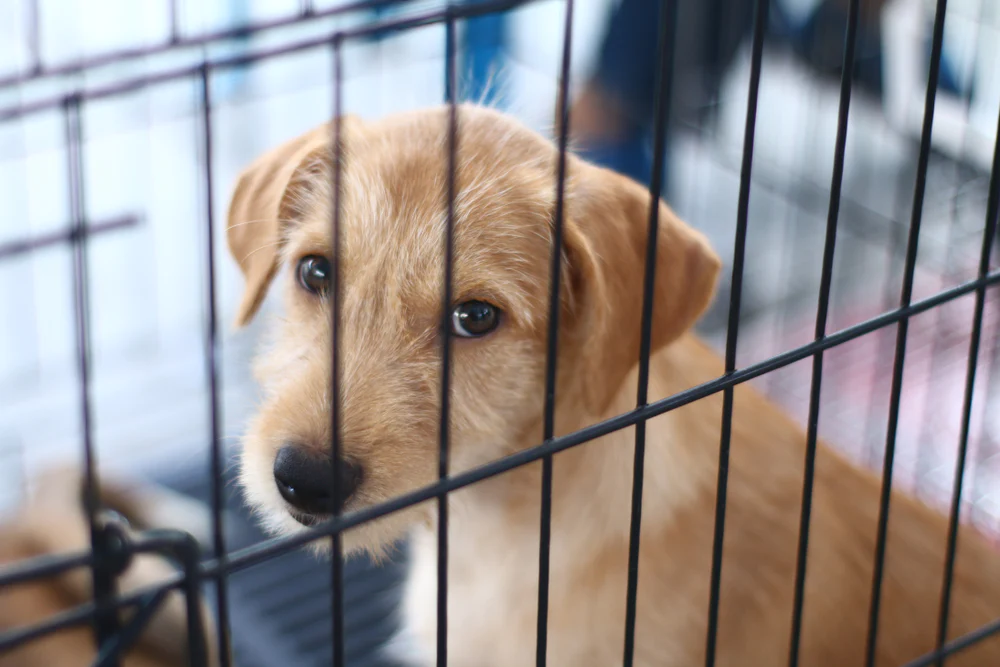
Claustrophobia refers to fear of enclosed spaces. Many people are uncomfortable in elevators. Did you know that dogs can also feel claustrophobic? Dogs can become anxious if they have to stay in tight spaces.
Although their wolf ancestors made safe and secure dens, canines can still feel fearful if they think they are being held in tight spots, such as a carrier.
Claustrophobia isn’t limited to dogs that are carried by their owners. It can also manifest in your home or outside.
Signs of Claustrophobia in Dogs
Dogs who are trapped in tight spaces and can’t move around in them are the main trigger for claustrophobia. This fear can become very intense as the dog’s instinct is to run away when they are afraid. Dogs that are kept in a crate will not be able to move and may show signs of anxiety and stress. It is easy to see if your dog is feeling claustrophobic. There are clear signs and symptoms that you can observe.
These are the most frequent signs:
- Whining Your dog may whine when they feel scared or anxious in a small space. Your dog might be vocalizing more than just this: barking, howling, and even screaming could all be signs that your dog is upset.
- Panting – A dog with claustrophobia is likely to be stressed when they are restricted. Your dog should feel comfortable in any tight spaces, whether it is a crate or a room.
- Shaking is a debilitating fear your dog might experience when they feel trapped in a narrow space with no escape. This could lead to shaking, drooling and hyperventilating. These symptoms can indicate that your dog is suffering from severe stress, which could even lead to death.
- Pacing An anxious or stressed dog may start to pace nervously in enclosed spaces.
Another sign your dog may be feeling claustrophobic might be a change in appetite when they enter an enclosed area. Dogs that refuse to eat or drink are likely to feel unsafe and stressed.
If these signs aren’t noticed in time, the dog may start to exhibit self-destructive behaviors like destructive chewing, biting, licking and chewing. Dogs could lick their fur or inflict bite wounds themselves if they are under too much stress.
Dogs that aren’t aware of these signs or ignore them will have serious behavioral problems. This is because they aren’t being provided for their mental and physical needs.
Claustrophobia and Dogs: The History

Throughout history, dogs were selectively bred for their highly social genes. Because of this, today’s dogs require our attention, time, and dedication. Even though we primarily have them for companionship, they require our companionship too.
Dogs that are kept in isolation feel the same way as humans. Dogs can feel lonely, frustrated, and stressed. This is a common problem that has been around for thousands of years. It has a lot to do with domestication.
Our canine companions are wolf ancestors. They loved snug, tight dens, as we have mentioned. They could keep their dogs safe and had full control of the area. They would react accordingly to any and all intrusions.
They would need to decide if they felt threatened. If so, they could either abandon the den and run, or fight for it. They would flee if they couldn’t. This instinct has remained strong until today. Dogs will flee from fearful situations if they feel it. This can include people, objects or other dogs.
If you place your dog in a crate while driving them around in a car, it is possible that they will become very anxious because they don’t like car rides and won’t be able to run away. They will begin to associate the crate and being in a confined space with the car ride they fear, and may become afraid of other enclosed spaces.
Dog Claustrophobia: The Science Behind It
Claustrophobia in dogs is the fear of restriction and can vary in intensity from one dog to another. Whether a dog will develop this fear is influenced by their genetics, conditioning, as well as the amygdala in their brain.

Because it is responsible for fear conditioning as well as the fight or flight response, the amygdala is a key player. Because they weren’t exposed as young dogs to confinement, a claustrophobic dog won’t be able to tolerate it. If puppies are crate trained incorrectly, they may fear the crate as a punishment. It will become a punishment that they associate with and will make it difficult for them to accept any other form of punishment.
Crate training should be a positive experience for them. They will not have such problems. You can encourage positive experiences in tight spaces by rewarding them with treats and rewards.
Claustrophobia-Suffering Dogs Can Be Training
Because claustrophobia in dogs isn’t caused by neurosis, there are ways to make sure that your dog doesn’t suffer from it. Training your dog from a young age is key. Puppy socialization, as well as obedience training, are the only ways that you can prepare your dog for their adult age.
These two actions will teach puppies how to accept and cope with confinement, whether they are being transported or hospitalized.
If your dog is already suffering from claustrophobia, behavior training may be necessary to help them overcome this fear. It involves making sure that they have positive experiences in confined spaces. Counter conditioning is a process that aims to transform the dog’s fearful and anxious reactions into positive, relaxed and happy ones.
Another method that has been proven to work is desensitization Training. The goal here is to reduce excessive reactions to the trigger (confined space, in this instance).